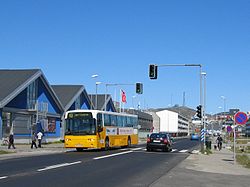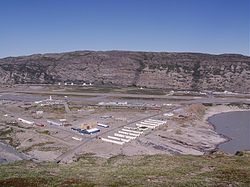| This article needs additional citations for verification. Please help improve this article by adding citations to reliable sources. Unsourced material may be challenged and removed. Find sources: "Transport in Greenland" – news · newspapers · books · scholar · JSTOR (December 2009) (Learn how and when to remove this message) |




The transportation system in Greenland is very unusual in that Greenland has no railways, no inland waterways, and virtually no roads between towns. Historically the major means of transportation has been by boat around the coast in summer and by dog sled in winter, particularly in the north and east. Nowadays air travel, by helicopter or other aircraft, is the main way of travel.
Air transport
Main article: List of airports in GreenlandWhile Germany occupied Denmark during World War II, the United States controlled Greenland and built bases and airports. The airports were codenamed as Bluie West One through to Bluie West Eight on the west of the island and Bluie East One to Blue East Four on the eastern side (some had only sea plane access, some no air access). The largest of those airports, Bluie West Eight, now renamed Kangerlussuaq Airport, became the international hub for travel to Greenland for decades, as it was the only airport that had a long enough runway to service large jets (not counting Thule Airbase). American authorities at one time entertained the idea of building a road from Kangerlussuaq to the second-largest airport, in Narsarsuaq, several hundred kilometres to the south. The idea was abandoned after feasibility studies failed to prove it was possible. These airbases are generally not located near settlements, so travellers needed an air transfer by helicopter (small plane from Kangerlussuaq) to reach settlements. All civil aviation matters are handled by the Civil Aviation Administration Denmark or the Greenland Airport Authority. In 2024, Nuuk Airport was extensively rebuilt and expanded, leading to the transition of the international hub from Kangerlussuaq.
Greenland has 18 airstrips, 14 of which are paved. Some are based on US airbases, but most are built by the Greenlandic government. All domestic flights are operated by Air Greenland. The name was anglicized in 2002 from the Danish Grønlandsfly (Air Greenland in English). Year-round scheduled International flights are to Copenhagen and Keflavík-Reykjavík Airport, Iceland. Other airlines operate seasonal and charter flights,
Icelandair flies from Keflavík-Reykjavík to Nuuk, Kulusuk, Ilulissat and Narsarsuaq. Air Greenland has also operated a route from Iqaluit in Canada to Nuuk during summer during some years.
Air cargo is very important for Greenland. Most perishable foodstuff is imported from Denmark by air. It uses the Air Greenland Copenhagen–Nuuk passenger aircraft, and this is a reason why such a large aircraft is used. The air containers are then transported to the other airports by small planes that can use the small runways. Previously, when Kangerlussuaq was the hub, some air cargo was transported by boat from Kangerlussuaq, but not in the winter when the Kangerlussuaq Fjord freezes (one of the reasons to build the Sisimiut–Kangerlussuaq road).
A state-owned firm called Kalaallit Airports is since 2017 tasked with operating and updating the airports in Nuuk and Ilulissat. This process has been contentious as Chinese firms bid for the contract, with one Danish PM stating "We don't want a communist dictatorship in our backyard."
Roads
There are no roads between settlements, only within them and around them. There are 150 km (90 mi) of roads in the whole country; 60 km (40 mi) of the roads are paved. The roads are primary or local roads, there are no highways in Greenland.
There is a 4.5 km long asphalt road between the towns of Ivittuut and Kangilinnguit.
Speed limit ranges from 50 kilometres per hour (31 mph) for local roads to 80 kilometres per hour (50 mph) on primary roads.
Some farms in the south have fairly extensive very simple roads for all-terrain vehicles (not included in the above figures), used for sheep farming and hay collection. There are some other short simple gravel roads, such as that leading from the shore to hydropower plants.
A 170-kilometre-long (110 mi) road between Sisimiut and Kangerlussuaq was discussed for several years. In 2015 the cost of it (500 million Danish krone) caused it to be replanned as a much less costly one-lane road for off-road vehicles. It was built in 2021 and 2022, at a cost of 25 million DKK (€3M). This road or wheel-track is of low quality and not included in the length of the road network.
Water transport
There are ports at Ilulissat, Kangerlussuaq (also known by its Danish name Søndre Strømfjord), Qaqortoq, Narsaq, Nuuk (Godthåb), Aasiaat and Sisimiut. Several other towns have also small ports. The main users of the harbors are Royal Arctic Line and Arctic Umiaq Line. Royal Arctic Line organises freight ships, for example container ships, with regular sailings from Denmark. Arctic Umiaq Line runs a passenger ship which also carries freight. The distance from Denmark to Nuuk by ship is 3,800 kilometres (2,400 mi/2,000 nmi/4 days at 20 knots), so more perishable foodstuff is imported by air.
There are no car ferries in or to Greenland. It is possible to transport cars as container freight with Royal Arctic Line (both domestic and from Denmark). Passengers must travel by another method. This is done mostly when moving or buying a car, not normally when travelling, as there is no large road network anywhere.
Many of the tourists to Greenland arrive by cruise ship.
Railways
Historically, special-purpose narrow gauge railways have operated, for purposes such as fish and mining.
- The Qoornoq X-press in the village of Qoornoq in the Nuuk fjord, . The 600 mm (1 ft 11+5⁄8 in) Qoornoq X-press was used for transporting fish from the harbour to scaffolds for drying. The railway cars were only flatbed wagon cars with no locomotives to move them. Built in 1955, the railway was abandoned shortly before the village around 1971.
- Malmbjerg
- Mestersvig – likely for the local mines that existed in the 1950s and 1960s
- Julianehaab
- Ivigtut – likely for the local mine that once operated in the community
- Disko Island near Qutdligssat
- Maamorilik
References
- "Greenland picks Denmark as airport project partner over Beijing". Reuters. 2018-09-10. Retrieved 2018-12-19.
- Simpson, John (2018-12-18). "Could Greenland become China's Arctic base?". BBC News. Retrieved 2018-12-19.
- "Ivittuut-Kangilinnguit Road, the only paved road in Greenland". www.dangerousroads.org. Retrieved 2022-12-26.
- "Historisk vejprojekt mellem Sisimiut og Kangerlussuaq undervejs" [Historic road project between Sisimiut and Kangerlussuaq ongoing] (in Danish). Bygge- & Anlægsavisen. 2021-05-11. Retrieved 2022-04-10.
- ATV-sporet mellem Kangerlussuaq og Sisimiut er færdig
- "Narrow gauge railway on Greenland".
- "Narrow gauge railway on Greenland". Retrieved June 17, 2011.
- "Narrow gauge railway on Greenland".
- "Narrow gauge railway on Greenland".
External links
![]() Media related to Transport in Greenland at Wikimedia Commons
Media related to Transport in Greenland at Wikimedia Commons
![]() Greenland travel guide from Wikivoyage
Greenland travel guide from Wikivoyage
| Greenland articles | |||||||
|---|---|---|---|---|---|---|---|
| |||||||
| History |  | ||||||
| Geography | |||||||
| Politics | |||||||
| Economy | |||||||
| Society |
| ||||||